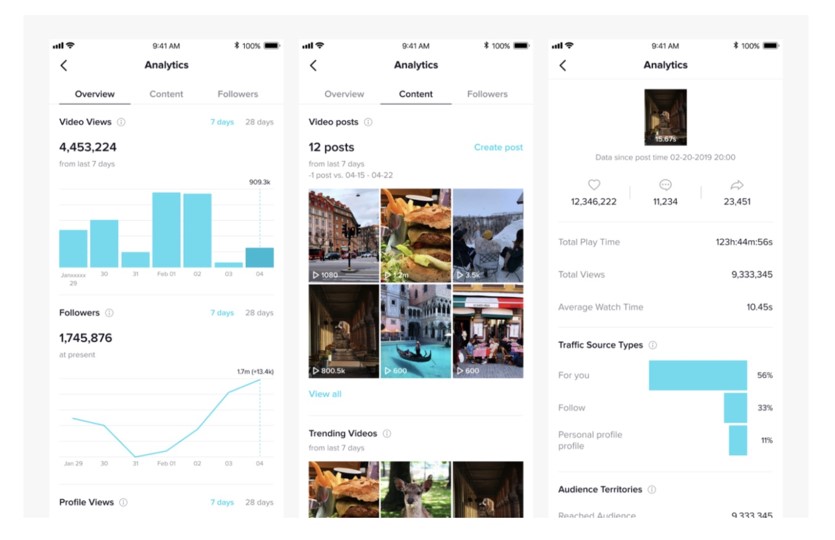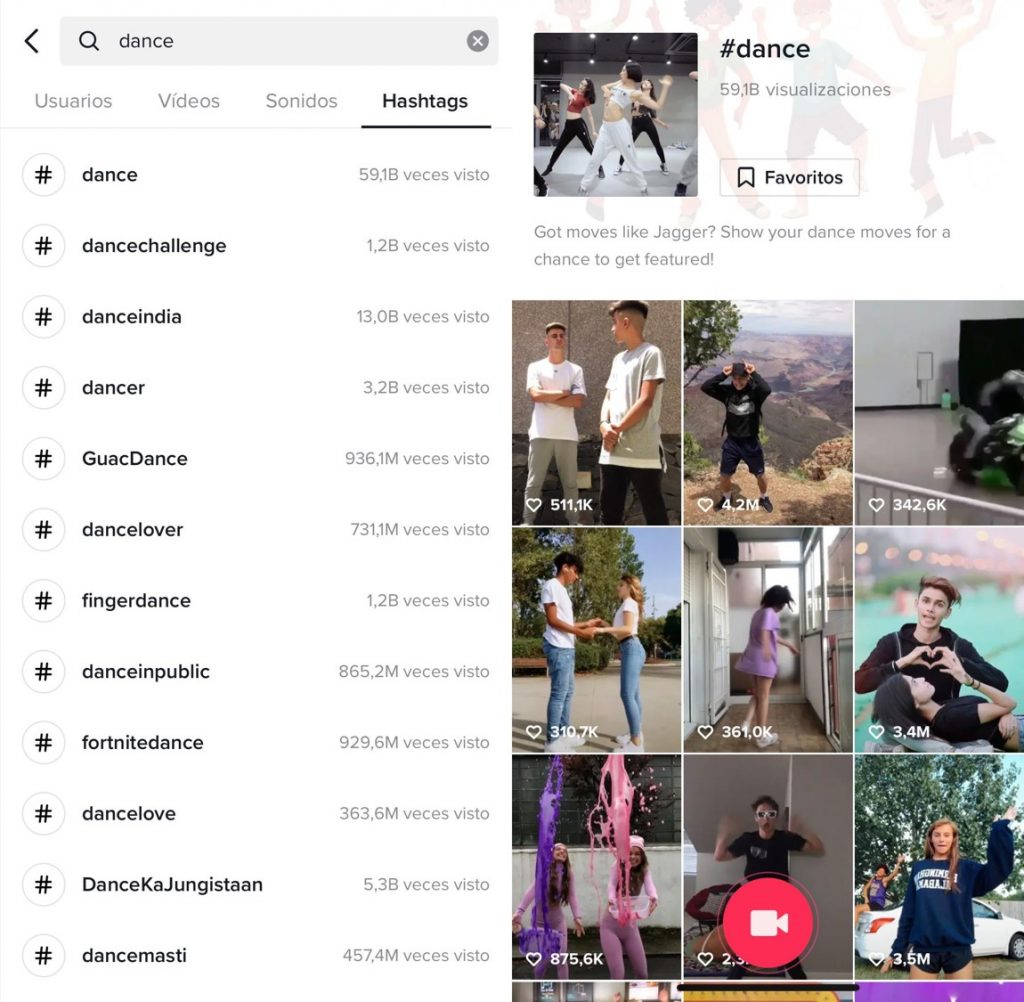TikTok Influencer Marketing Guide, Metrics and KPI
This is the complete guide to Influencer Marketing on TikTok, Metrics and KPI for your marketing strategy.
These days TikTok is everywhere as the latest trend in social media, and it’s almost impossible to ignore. TikTok is a social media that allows users to create and share short videos. Users create and share funny videos that last anywhere from 15 seconds to 3 minutes.
Originally launched in 2016 as Musical.ly, TikTok has been growing in popularity over the years.
How does it work?
When you open your TikTok account, you see a feed that shows you a variety of videos. As seen in the image below, the videos are organized into a general category based on a topic, hashtag or account. Like Instagram, there is a Discover or Trending section to find new videos, as well as hashtags that allow you to find similar content. TikTok also personalizes your feed based on the videos you watch and the accounts you interact with.

All of this may seem reminiscent of other social media apps such as Snapchat, Instagram or the now extinct Vine. Yes, users interact through views, likes, comments, shares, as is common with other social media platforms, but the nature of the content they create and share is quite different. To understand this better, check out these tips about TikTok.
6 Tips about TikTok Content
1- Since TikTok content is mostly public, it’s difficult to obtain constant metrics regarding performance, as it doesn’t have a fixed user base to target (like Instagram for example). A video can have 10k views and the following 50k views, it all depends on whether TikTok promotes your content or not.
Check out the main trends for influencer marketing content
2- How to promote your content? TikTok more than any other social media network, the use of hashtags, music and trending audios is of vital importance. Using a trending audio can make a video go viral in seconds.
3- Replicable videos. One tactic that works to boost your video content is that it can be replicated by other users or “replied” through TikTok tools such as “TikTok Duo”.
4- Duration less than 20 seconds. Attention spans are narrow, it is better to create short TikToks.
5- Content that works: Challenges, Dances, Mini sketches with audio, Satisfying videos, or “Hacks”.
6- For content that showcases products, it’s recommended to create short videos depicting use scenarios, supported by signs or indications if necessary, but with a popular audio. If the influencer is going to talk, it works better if it’s in the form of a character or comical profile.
TikTok Metrics
Like any social media platform, there are several metrics and performance indicators available in the app. Although all of them are useful, we want to highlight the 4 most important TikTok metrics that you should measure when managing your marketing strategy:

#1 Number of videos posted
The total number of videos posted is a metric that shows how many videos an account has posted during a given time period. It seems basic, but on a platform like TikTok this can sometimes be your “north star” metric. Assuming your content is engaging and the audience finds it entertaining/informative, the number of TikToks you post will correlate highly with the growth and impact of your accounts.
Regarding your brand’s influencer or collaborator account, this metric is also critical. Even if you’re only providing the budget for a few pieces of content, it’s important that the influencers you partner with are actively and consistently engaging an audience.
#2 Engagement Rate per Post
Engagement is an important part of measuring the success of any social media campaign. The Average Engagement Rate per Post metric gives you insight into how your campaign is performing at each level so you can adjust your strategy accordingly.
Engagement refers to the meaningful interactions people have with your TikTok videos, including likes and comments. Of course, the higher the engagement rate, the better.
When working with influencers, you can use their average engagement rate per post as a metric to assess whether it would be worth the ROI. An influencer with a smaller audience but a higher engagement rate could be a much better investment than a more prominent influencer with millions of fans.
#3 Followers growth
Total follower growth is the number of followers a profile has gained in a 30-day period. This is a key metric to track when working with influencers on TikTok. The idea is to also partner with contnet creators that can provide a good ROI in the future.
It’s critical to keep in mind that TikTok doesn’t work like most social media apps. The app’s algorithm is not chronological and if a piece of content performs well over time, it will continue to be shown to users long after the initial published date. This means that if you invest in and partner with creators who grow their audiences quickly, the ROI of your influencer marketing campaigns can increase over time.
#4 Hashtag Growth
Hashtag growth is a good way to track the hashtags you create for a campaign. For example, you can use different influencers to create a challenge for your brand. If the challenge goes viral and receives a lot of participation from other TikTok users, the hashtags will ensure that your brand and campaign are always referenced.
Alternatively, you can use the hashtag growth metrics to track the top performing hashtags on the platform to get ideas on the type of content to create and trends to follow. If the influencers you work with on TikTok use a set of recurring hashtags, it may be worth looking at the growth of these as well.

Influencer Marketing on TikTok vs Other Social Media
TikTok is a unique social media platform where the potential to go viral can skyrocket your brand’s reach and engagement. By combining the appropriate TikTok strategy with the right influencers, monitoring the right metrics over time and using them to continually improve campaigns, your brand can find significant ROI.

However, when looking at metrics, be aware that TikTok calculates them differently and with big differences when compared to other social media.
The metrics in TikTok with the biggest difference in comparison to other networks is the Engagement Rate. In TikTok the engagement rate is usually calculated as (likes + comments+ shares) / total impressions. However, VoxFeed and all other social media calculate the engagement rate as: (likes + comments + shares) / total followers – this makes it difficult to establish a comparison of this metric vs. the other networks.
More about Engagement Rate
The problem with calculating Engagement Rate (ER) by total impressions is that you may think someone has a high ER, but in reality it’s because the base of views is usually smaller compared to the number of followers a profile has. That in repercussion means that the basis for the calculation is variable and makes it more difficult to pull an average and make a comparison between them. If you take it on total followers like VoxFeed, it is relatively the same base for all posts and you can actually get an estimate.
Considering the ER by total followers, it’ s normal that the % is low. That’s because of how TikTok and its algorithm works. Many of the views come from the “For you page” instead of “Following”, so there is no clear relationship between the number of followers and the number of views a video may have.
Regarding the Cost per Engagement (CPE), this is quite similar to Instagram. The CPE is on average $0.10 or less for good campaigns, or as much as $0.30 depending on the brand or message to promote. In fact for most influencers their cost per post is usually the same or less than Instagram, unless they are native TikTokers.
For reference, here are some benchmarks of the campaigns that have been implemented in VoxFeed, considering the engagement rate over the total number of followers:

